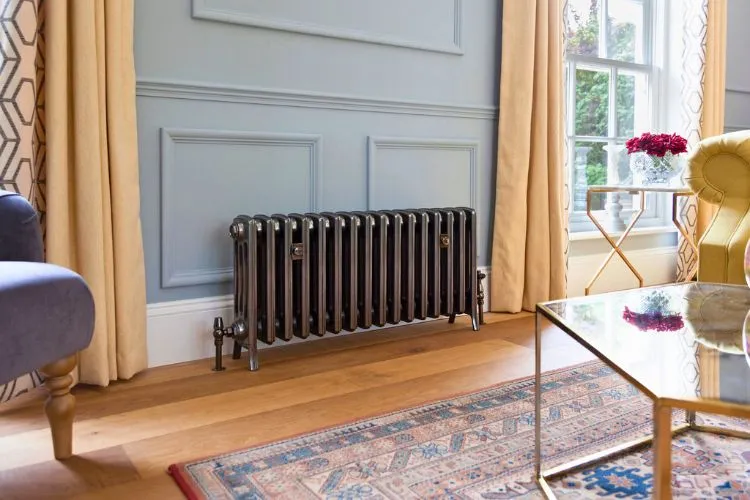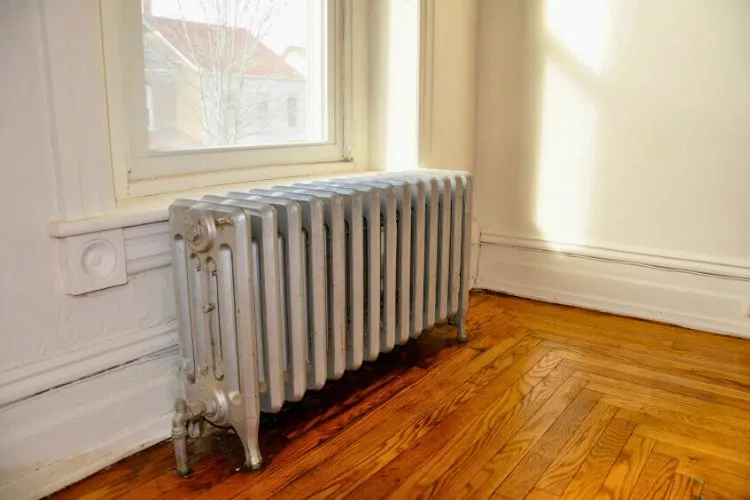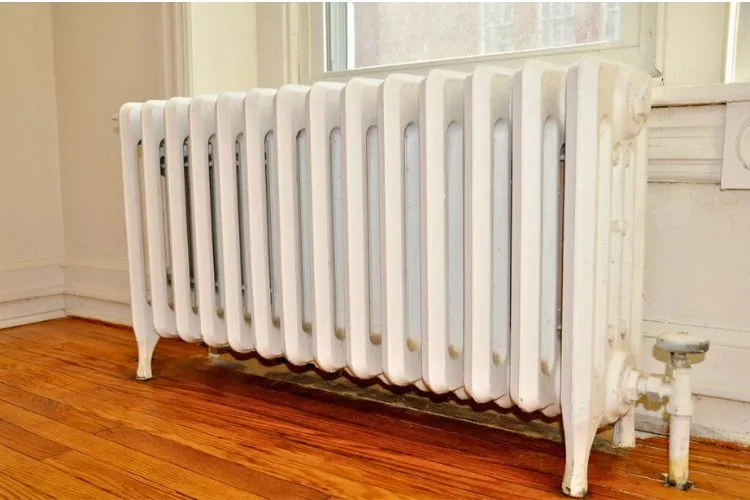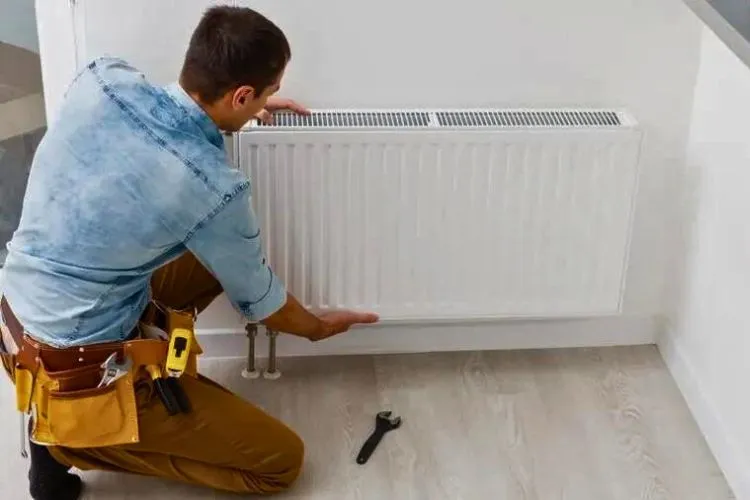Radiators form a crucial part of our heating systems, especially in the colder months. However, it’s important for homeowners and occupants to understand any potential safety risks associated with radiators.
This article digs into the question, “Can radiators start fires?”
We’ll discuss how radiators work, conditions that might increase fire risks, and tips to prevent any potential hazards.

Understanding Radiators
A radiator is a device that transfers heat to a space, warming your rooms during cold weather. You might find different types of radiators in homes, such as steam, electric, and gas radiators.

- Steam radiators use steam from a boiler that heats the enclosure and releases heat into the room.
- Electric radiators rely on electrical energy and convert it into heat using an internal resistor.
- Gas radiators use natural gas or propane to produce heat, and they require venting to release the combustion byproducts.
Each type of radiator has its own heating methods, which may affect the possibility of fire hazards.
Can Radiators Start Fires?
Radiators typically have low fire risks, but certain conditions and events can increase the likelihood of fires.
Here, we’ll examine various factors that might contribute to potential fire risks.
Steam Radiators
Steam radiators have a low risk of causing fires. The steam itself is not flammable and generally poses minimal fire risk.
However, overheating can cause damage to the radiator’s enclosure, which could result in a fire if the enclosure or other materials near the radiator combust. Careful maintenance and regular inspection are key to keeping steam radiators safe.
Electric Radiators
Electric radiators rely on electrical energy and can pose some danger if exposed to faulty wiring or electrical surges. In rare instances, wiring issues or internal resistor malfunctions can lead to sparks, which could start a fire.
To avoid fire risks with electric radiators, use a certified electrician to install or maintain them, and ensure they’re in compliance with electrical safety codes.
Gas Radiators
Gas radiators have the potential to cause fires if they malfunction or are not properly maintained. Leaking natural gas or propane can accumulate around the radiator, and a single spark could ignite the gas, resulting in a fire or explosion.
To minimize the risk of a fire, install a gas leak detector, schedule regular maintenance, and ensure an annual inspection is carried out by a professional.
Where Should You Not Place a Radiator?
Knowing where not to put a radiator is just as vital as understanding its proper placement. Incorrect location can lead to heat loss, uneven room temperatures, potential fire hazards, and an inefficient heating system.

Here are several places you should avoid when installing radiators:
- Behind Large Furniture: Placing a radiator behind large furniture like a sofa or cabinet can block heat distribution. The furniture absorbs the heat instead of allowing it to circulate freely in the room. This setup is inefficient and can lead to increased heating costs.
- Under Windows: Conventionally, it was common to place radiators under windows to counteract the cooler air with the radiator’s heat. Today, with most homes having double glazing and better insulation, this practice is not as beneficial. The heat can be lost through the windows, leading to inefficiencies.
- In Hallways or Unused Spaces: Radiators should always be placed in areas where heat is required. Installing a radiator in a corridor or other spaces that are not typically in use can waste energy and drive up costs.
- Near Flammable Materials: As a safety precaution, avoid installing your radiator near curtains, clothes, or any flammable material. Radiators emit heat and placing them near these items can potentially create a fire risk.
- Near Electronic Devices: Similarly, avoid placing the radiator near electronic devices. The heat generated by the radiator can affect the device’s performance or even damage it over time.
- In a Concealed Spot: Radiators work more efficiently when they are placed in a spot where air can circulate freely. Keep your radiators exposed and avoid boxing them in or placing them in recessed locations.
Always remember, efficient radiator installation requires clear access for maintenance, good airflow for excellent heat distribution, and adherence to safety measures. It’s best to consult with a heating professional to understand the best spots in your home for radiator installation.
Safety Measures to Prevent Fires
Regardless of the type of radiator you own, there are several ways to prevent fires and ensure safe operation. Consider these safety tips for your home heating system.

Proper Installation and Maintenance
Proper installation is the first step in keeping your radiators safe and functional. Hire a professional (for gas and electric radiators) and follow the manufacturer’s guidelines for installation.
Regular maintenance is crucial in preventing problems or malfunctions that could lead to fires. This includes boiler maintenance for steam radiators, inspection of electrical components for electric radiators, and yearly inspections for gas radiators.
Positioning of Radiators and Nearby Items
Ensuring a safe distance between your radiators and flammable materials is essential in reducing fire risks. Be cautious when placing furniture, curtains, or other flammable items near your radiators.
Avoid placing clothes, paper, or any other combustible materials on or near your radiator. Create a safe zone around it, keeping at least a few feet of clearance.
Avoid Overheating and Sparks
Check your radiator’s temperature regularly to ensure it doesn’t overheat. If you notice the temperature climbing too high, shut off the radiator and have it inspected by a professional.
For electric radiators, use a surge protector to shield against electrical surges and avoid plugging in other high-wattage devices into the same outlet.
Frequently Asked Question (FAQs)
Is it safe to leave clothes on a radiator overnight?
No, it’s not safe to leave clothes on a radiator overnight. It may appear like an effective drying method, but it can pose a significant fire hazard. Clothes can become overly dry and potentially combustible, leading to a fire. Additionally, it could cause the radiator to overheat, which can lead to long term damage. It is always advisable to dry clothes on a dedicated clothes rack or line to ensure safety.
Is it safe to put a bed next to a radiator?
Placing a bed next to a radiator should be avoided. It can lead to the bed absorbing the heat instead of it being distributed through the room. This might not only lead to an inefficient heating system but also pose a potential fire risk. Bedding materials and mattresses can become overly dry, leading to them becoming fire hazards. Always ensure there is enough distance between your bed and the radiator, ideally a few feet.
Can I cover my radiator with a blanket?
No, covering your radiator with a blanket is not recommended. It can obstruct the heat emitted from the radiator, preventing proper heat distribution in your room. Particularly with fabric materials, this could also pose a fire risk as the blanket can overheat and potentially ignite. If you’re not satisfied with how your radiator looks, you might want to consider radiator covers that are designed to be safe and allow proper airflow.
Can curtains catch fire from a radiator?
While it’s less likely for curtains to catch fire from a radiator due to direct contact, it’s possible if the curtains come into touch with a very hot radiator for an extended period, especially if the materials of the curtains are highly flammable. Similarly, steam radiators can overheat, posing a risk of scorching or fire. Therefore, it’s always safe to ensure a distance of a few feet between the radiator and the curtains to prevent any fire hazard.
Can old or improperly maintained radiators lead to fires?
Improperly maintained radiators can pose a higher risk of fires, regardless of their age. Regular inspection and maintenance can ensure the safe operation of radiators, helping prevent potential fire hazards.
What is the safe distance between radiators and flammable materials?
It’s best to have at least a few feet of clearance between radiators and flammable materials to reduce the risk of fires.
Conclusion:
Radiators can start fires in rare instances and under specific conditions, but following proper safety precautions can greatly reduce the risk of fire hazards.
Regular maintenance, appropriate positioning, and vigilance are essential in ensuring your radiators remain practical and safe devices within your home. Always be cautious and consult professionals if you suspect any issues with your radiator systems.


